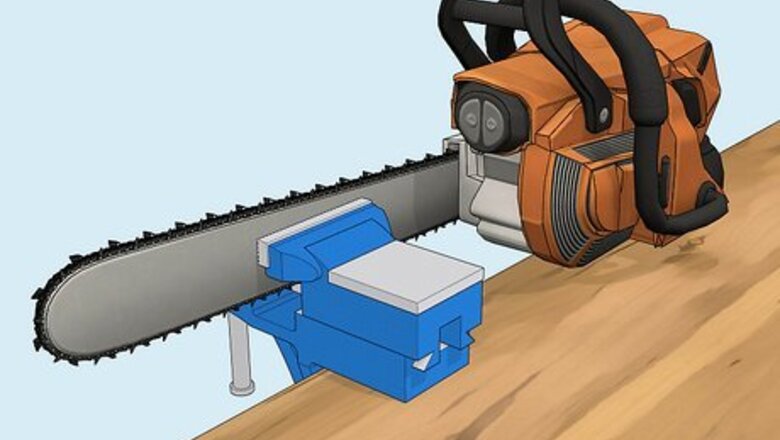
views
- Place the bar of the chainsaw in a tabletop vice, and tighten the tension of the chain so that it doesn’t move around as you work.
- Use a file guide to position a round file at an angle to the cutter, or align the file with the guidelines on the tooth.
- File toward the point of the cutter 3-10 times, or until the cutter is silver, indicating it’s been adequately sharpened.
- Use a depth gauge to measure the height of each raker, and file down any that stick up past the top of the gauge.
Setting the File
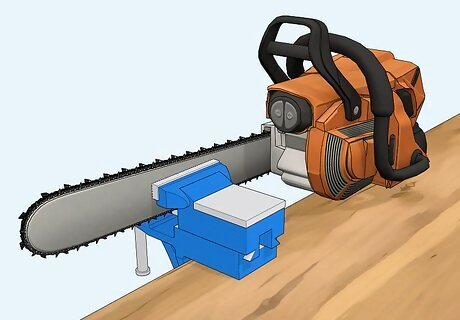
Clamp the bar of the chainsaw to your work surface. Use a tabletop clamp or a vise to hold the chainsaw in place on your work surface. This will prevent the saw from shifting as you sharpen it, and result in a much more consistent and easy sharpening process.Note: If you need to sharpen a chainsaw but don’t have a vise or clamp, you can go without it. Be careful to keep the chainsaw steady as you file it if you can’t secure it in place, and wear sturdy gloves as your work. Securing the chainsaw upside down on your work surface often makes for easier access to the chain. There’s no one right way, so find the method that works best for you.
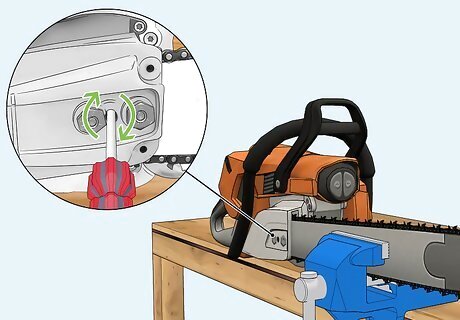
Tighten the tension-adjusting screw to tighten the chain. Find the tension adjusting screw on your chainsaw—usually on the side of the saw and perpendicular to the direction of the chain. Use a screwdriver to tighten the chain by tightening this screw. Make sure the chain is tight, but is still able to move around the saw with a little effort. This stops the chain from moving as you sharpen it.Tip: The adjustment screw will be in different places on different chainsaws. Consult your owner’s manual for the chainsaw if you can’t find it.
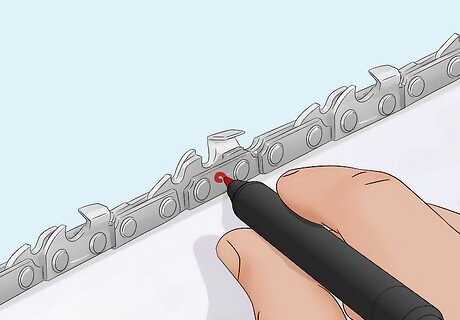
Mark your first tooth with a permanent marker. Select a tooth to sharpen first (most commonly the shortest or smallest tooth) and mark it with a bright permanent marker to easily keep track of where you started and prevent you from sharpening the same section twice. As you use the chainsaw, this mark will disappear. If you don’t want to mark your chainsaw, look for a unique link in the chain. It might have no teeth, or already be a different color. Alternatively, mark the tooth with a bit of painter’s tape after you’ve filed it.
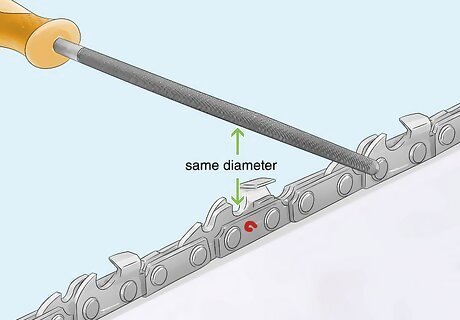
Select a round file the same diameter as the chainsaw's teeth. Different chainsaws have different sized teeth, and therefore require different sized files to sharpen. Find the size of your saw’s chain in the owner’s manual or online, or read the information occasionally printed on the bar of the chainsaw.Note: Typical sizes for the chain are ⁄16 inch (4.8 mm), ⁄32 inch (4.0 mm), and ⁄32 inch (5.6 mm) in diameter.
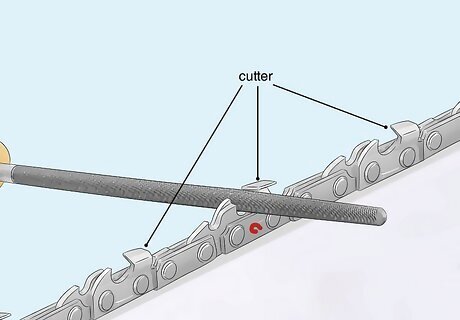
Set your file in the notch on the front of the cutter. The cutter is the angled “tooth” with a flat top, which rips at the wood. Place the tip of the file just inside the notch on the tooth you have marked so that roughly 20% of the file’s diameter is above the top of the tooth. The chain has two types of cutters facing alternate directions. Choose one direction of cutter to focus on first before moving onto the other type.
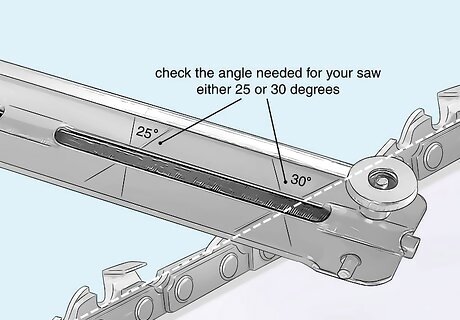
Position your file guide at the factory default angle of the cutter. Check your owner's manual or look online to find the correct angle at which to file each cutter. Position the line on the file holder so that it lines up parallel to the rest of the chain as you file. Some chainsaws also have lines etched into the top of each cutter to help guide your file at the appropriate angle. Line your file up so that it is parallel with this etching to set the proper angle. The angle for filing is typically 25 or 30 degrees, but some may be flatter. Always check the angle needed for your saw before beginning.
Sharpening the Cutters
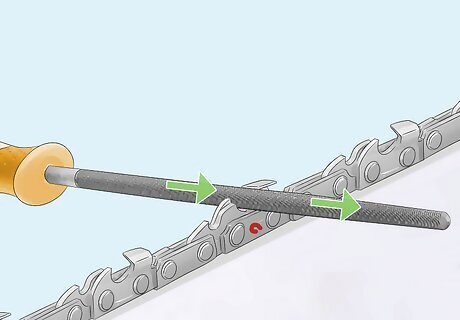
Slide the file across the face of the cutter. Hold the file so that it remains level and flat over the top of the chain. In one smooth motion, push the file along the cutter. You don’t need to apply a lot of pressure, only enough so that you feel the file grinding against the cutter. Lift the file out of the cutter and reset it to the same place and at the same angle as it was previously.Note: Never pull the file backward through the cutter, as this will damage both your file and the cutter itself.
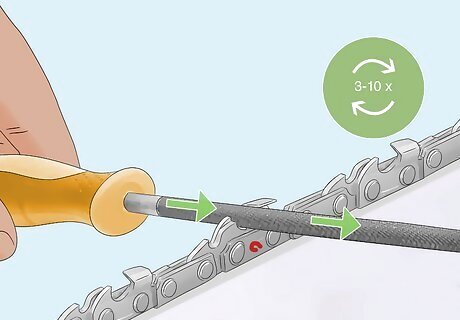
File the cutter 3 to 10 times until it is sharp. Repeat the exact same motion of running the file through the cutter until the cutter is a shiny, silver color and appears sharp. To ensure consistency across the sharpness of each cutter, count how many times you file the first cutter and file each subsequent cutter the same number of times. If you’re unsure whether or not the cutter is sharp, feel for a slight burr along the top of the cutter. If this is present, the cutter is adequately sharpened. Run the file over the burr once to knock it away. If you notice metal shavings getting caught in the file, simply tap the file on a solid surface to clear it and continue sharpening.
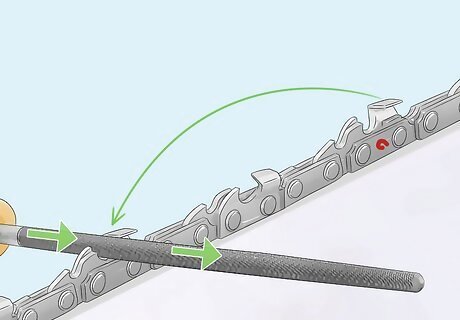
Sharpen every second tooth from the starting point. Once you have fully sharpened your starting tooth, rotate the chain to bring a new tooth closer. The cutters on a chainsaw alternate directions, so sharpen every other cutter using the same motion, at the same angle, the same number of times until it is sharp. Repeat until you get back to the starting mark you made.These two cutters are referred to as right and left cutters. By alternating them, the chainsaw is more easily able to cut in a straight line without leaning to one side or another. If you file one type of cutter more than another, you risk throwing the balance of the chainsaw off. Make sure you stay consistent across all cutters.
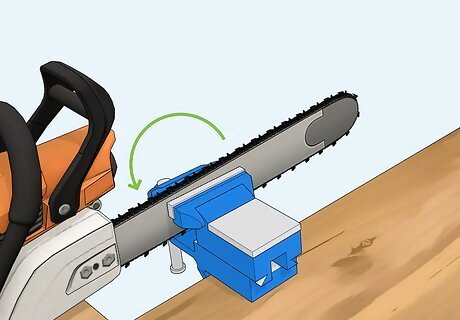
Rotate the chainsaw 180 degrees. Loosen your vise or clamp and rotate the chainsaw 180 degrees, then clamp it again. This grants access to the alternate cutters that you skipped sharpening in the first loop around the chain and means you don’t need to change your stance or method.Tip: If you can’t easily adjust the position in which the chainsaw is clamped, step around the chainsaw or adjust the position of your file so that it faces the other direction. Regardless, make sure you remain consistent.
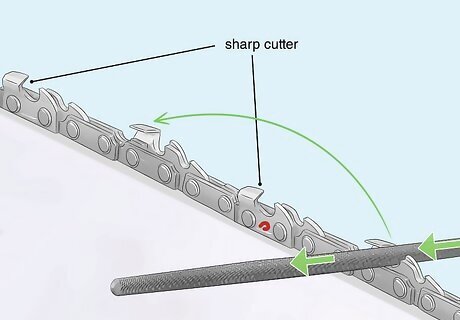
Use the same motion to sharpen every other tooth. File your way around the chain again, sharpening each tooth that has not yet been sharpened. Make sure to use the same amount of pressure and run the file through the same amount of times in order to keep each cutter consistent and level.
Filing the Rakers
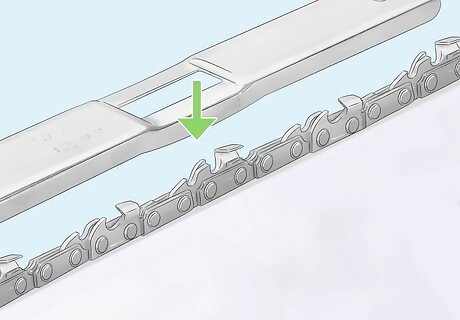
Place a depth gauge over the chain and check the rakers. A depth gauge is a tool used to ensure that the rakers are at the proper height. Set the depth gauge over the chain near your starting point so that the “wings” face downward, and push it forward until it catches against a raker. This indicates the raker needs to be filed down.The rakers are the bumps along the chain in between each cutter. They function to keep the depth of the cut consistent as the chain spins around the saw, so making sure each is level is very important.
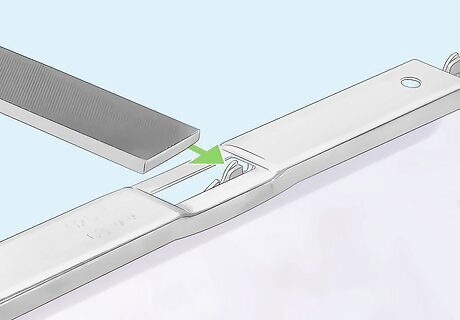
Use a flat file to level the raker to the gauge. Holding the depth gauge in place, run a flat file over the top of the raker until it is level with the depth gauge. While the depth gauge will protect other teeth from being filed, there is nothing to stop the gauge itself from being filed down. Use sparing pressure, and be careful not to file away the gauge, as this can lead to inconsistencies between rakers. To entirely avoid filing the gauge, slide it back while you file over the raker. Check the height of the raker consistently as you file until it lines up with the top of the depth gauge. Once you have filed the raker down, it might have a square top. Use the flat file to very slightly smooth off the edges without filing down the height of the raker any further. Unlike the round file, the flat file doesn’t need to be any specific size.
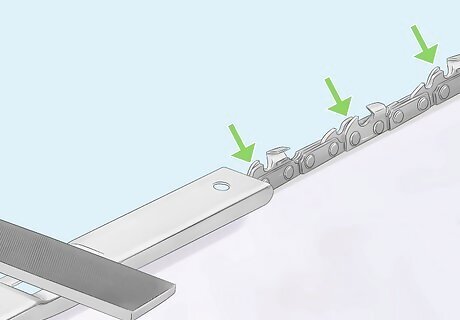
File every raker down to the top of the depth gauge. Continue the same process of checking rakers with a depth gauge and filing them down all the way around the rest of the chain. Unlike the cutters, you don’t need to worry about filing the same raker twice as you are filing the rakers down.Tip: As with the round file, if you notice any metal shavings getting caught up in the flat file, tap it on a surface once or twice to loosen them before continuing to file.
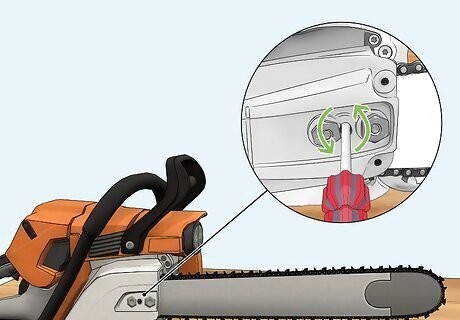
Loosen the chain and release the chainsaw. Use the adjustment screws to loosen the chain back to a usable tension. Loosen the clamp or vise holding the chainsaw in place and take the chainsaw out. Your chainsaw is now be sharpened evenly and ready to use. A chain at a usable tension has very little visible slack as you hold it. When you lift the chain up, it should have around ⁄8 inch (3.2 mm) of give and snap back when released.
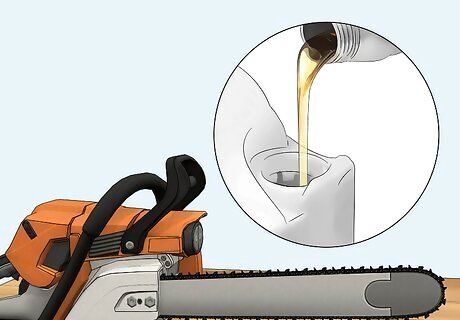
Refill the bar oil reservoir in your chainsaw, and clean the saw. Turn your chainsaw on its side to reveal the cap for the oil reservoir. Unscrew the cap and use a funnel to pour in bar and chain oil. Replace the cap and secure it tightly. After, clean your chainsaw to remove any filing debris before you operate it. As a rule of thumb, sharpen your chainsaw every time you refill the oil—and refill the oil every time you refill the gas tank!Tip: Vegetable oil, such as canola oil, can be used in place of bar and chain oil. This is biodegradable and therefore more environmentally friendly.



















Comments
0 comment